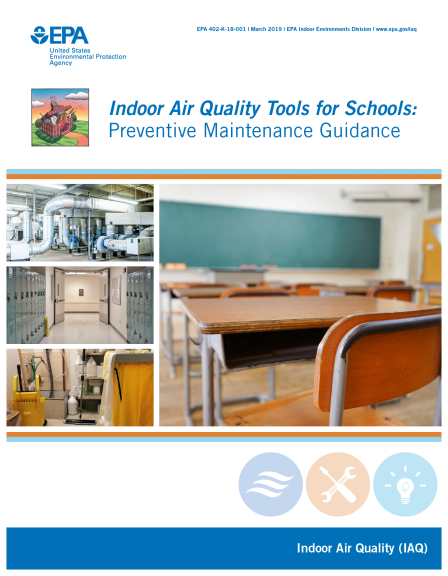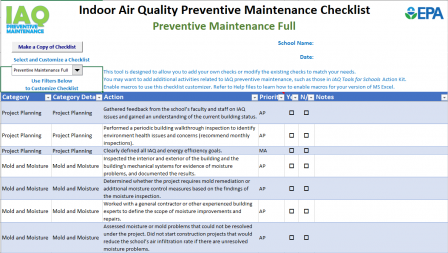On this page:
- Introduction
- The Value of IAQ Preventive Maintenance: Saving Costs with Healthy, Reliable and Efficient Buildings
- Making the Case
- Develop Your Plan
- Staffing and Communication
- Evaluation
- Appendices
- References
Introduction
You can prevent many issues from becoming costly problems through preventive maintenance with thoughtful planning and regular maintenance for your buildings and facilities. This guide will walk you through straightforward steps to develop and implement a sustainable indoor air quality (IAQ) preventive maintenance plan for your school district (see Graphic 1). On the following pages, you will find powerful information to help you make the case for your plan and gain the buy-in you need from your school community. You also will find detailed guidance on walkthroughs and assessments of your facilities and how to address common IAQ issues by implementing IAQ Technical Solutions, including integrated pest management (IPM); green cleaning; heating, ventilating and air conditioning (HVAC) and equipment upkeep; mold and moisture prevention; and other pollutant source control activities. Finally, you’ll find tips on staffing and communication, as well as evaluating your activities to make your IAQ preventive maintenance plan a success.
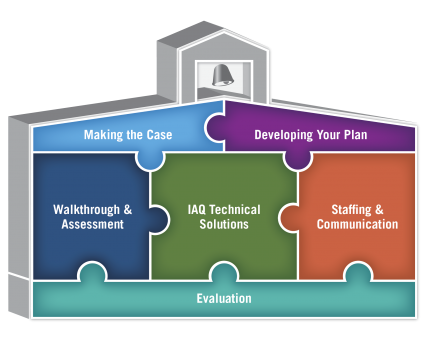 Graphic 1. These topics are covered in this guidance to help you develop an IAQ preventive maintenance plan.Use this voluntary guide1 to get started or enhance your own IAQ preventive maintenance activities. This guide, along with EPA’s IAQ Preventive Maintenance Checklist and templates, can help you build a thorough program for keeping your school buildings healthy, reliable and efficient.2 Even though this guide is focused on IAQ preventive maintenance, you can use the tools, tips and strategies found here in a more general preventive maintenance plan or your overall IAQ management program. EPA’s IAQ Tools for Schools suite of guidance, including the Indoor Air Quality Tools for Schools Action Kit and the Framework for Effective School IAQ Management, provide additional proven and widely adopted guidance to help you create, adopt and sustain an IAQ preventive maintenance plan.
Graphic 1. These topics are covered in this guidance to help you develop an IAQ preventive maintenance plan.Use this voluntary guide1 to get started or enhance your own IAQ preventive maintenance activities. This guide, along with EPA’s IAQ Preventive Maintenance Checklist and templates, can help you build a thorough program for keeping your school buildings healthy, reliable and efficient.2 Even though this guide is focused on IAQ preventive maintenance, you can use the tools, tips and strategies found here in a more general preventive maintenance plan or your overall IAQ management program. EPA’s IAQ Tools for Schools suite of guidance, including the Indoor Air Quality Tools for Schools Action Kit and the Framework for Effective School IAQ Management, provide additional proven and widely adopted guidance to help you create, adopt and sustain an IAQ preventive maintenance plan.
There are four important steps to take to develop an IAQ preventive maintenance plan (see Graphic 2). These steps can be followed in any order that fits your situation. Depending on the steps a school district has already taken to implement IAQ preventive maintenance best practices, the staff could start at any of these steps. For example, a school district might already have a committed team in place, as well as buy-in from the superintendent and staff, and therefore could start at Develop Your Plan.
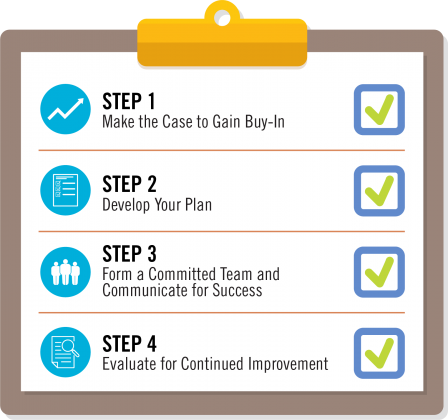 Graphic 2. Take these important steps to develop an IAQ preventive maintenance plan.
Graphic 2. Take these important steps to develop an IAQ preventive maintenance plan.
The Value of IAQ Preventive Maintenance: Saving Costs with Healthy, Reliable and Efficient Buildings
“We’re in the business of educating children. So, what really has been a strong driver for us is whether we can operate our buildings more efficiently and do so in such a way that our students are better able to perform and want to be at school. Every dollar that is saved from an energy and preventive maintenance standpoint is a dollar that can be spent toward educating our children and keeping them healthy.”
—Dave Berger, Construction Services
Specialist, Des Moines Public Schools, Iowa
Saving money while keeping buildings safe and reliable is one of the top priorities in most schools across the nation, and this document will help equip you to make this happen. Here you will find guidance for developing a comprehensive approach to IAQ preventive maintenance that includes energy efficiency and helps to cut costs. As shown in Graphic 3, integrating IAQ management, preventive maintenance and energy efficiency helps ensure healthy, efficient learning environments and smooth building operations.
Preventive maintenance is a sound financial investment. Every dollar spent on preventive maintenance yields $4 in savings by avoiding the costs of future repair or replacement of building systems.3
A good preventive maintenance program includes routine and regular maintenance and repair, which keeps equipment and facilities performing reliably and as intended. It helps your equipment have a longer life span and saves schools from unexpected, costly repairs. Putting off or deferring system maintenance usually increases overall costs, unplanned repairs and the risk of premature facility failure.4
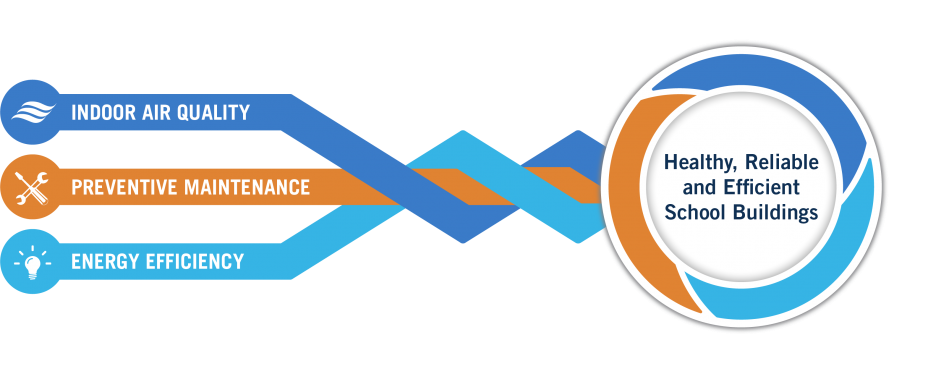 Graphic 3. A preventive maintenance plan that includes IAQ and energy efficiency can cut costs while ensuring healthy, reliable and efficient buildings.
Graphic 3. A preventive maintenance plan that includes IAQ and energy efficiency can cut costs while ensuring healthy, reliable and efficient buildings.
 Increase revenue and improve health with a team approach to integrating preventive maintenance, IAQ management and energy efficiency.
Increase revenue and improve health with a team approach to integrating preventive maintenance, IAQ management and energy efficiency.
Girish Nair, Diane Rhodes, Larry Fowler, Kathy Hardin and Nick Kellar (pictured from left to right) are working to maintain healthy indoor environments at North East Independent School District in Texas in cooperation with campus nurses, custodial staff, PE teachers, administrators and district facility maintenance staff.
Focusing on IAQ management in your preventive maintenance activities will help to ensure healthy indoor environments in schools. Poor IAQ can cause health problems, such as respiratory irritation, sore throats, asthma attacks, drowsiness and headaches; it also can make it hard to concentrate.5The scientific evidence continues to mount, demonstrating that when student and staff health is impacted, learning and performance also are affected.6,7 A successful preventive maintenance program addresses the causes of poor IAQ and also can minimize pollutants in the air children and staff breathe in schools, ensure adequate ventilation and increase efficiency of building operations, therefore saving energy and costs. However, if you do not pay careful attention to how energy management and IAQ affect each other, student and staff health and performance can suffer. If not performed correctly, energy management activities can create dust; disturb hazardous materials, such as asbestos, lead and polychlorinated biphenyls (PCBs); bring new contaminants into the HVAC system or create new places for them to enter; create or increase moisture problems; and result in inadequate ventilation in occupied spaces.5 Ignoring these issues can cause IAQ problems that lead to expensive repairs.8
Healthy Buildings
Ensuring the school environment is healthy is essential because the health and comfort of students and staff are among the many factors that contribute to learning and productivity in the classroom, which in turn affect performance and achievement. Children especially are vulnerable to poor environmental conditions, and being exposed to such contaminants early in life can cause health problems well into adulthood. Indoor pollutants in schools include mold, dust, volatile organic compounds (VOCs), radon, lead, asbestos, PCBs, pesticides, secondhand smoke, and others (find more information in IAQ Technical Solutions). Some of these pollutants can cause or exacerbate such health issues as allergies, respiratory illnesses like asthma and infectious diseases like the flu.
By putting a preventive maintenance program in place to prevent IAQ issues and by acting quickly to address IAQ problems as they happen, school districts can protect students’ and staff members’ health, which also saves money.9 In some states, the funding formula for state aid includes average daily attendance, and a daily rate is calculated based on total enrollment. For example, in Texas, the North East Independent School District’s asthma program works to lower the number of missed school days for students with asthma by reducing asthma triggers. Improving attendance rates for all 8,000 students with asthma in the district by only 1 day will generate $267,552 in state revenue per year.10
Reliable Buildings
“Preventive maintenance is important to extend the life cycle of equipment and helps schools budget for the future. If you know an expensive equipment item will last 20 years, you can put budget dollars aside over time for replacements.”
—Fred Remelius, Director of Operations, Upper Merion Area School District, Pennsylvania
U.S.EPA. 2017. “A Proactive Approach to IAQ: Saving Money and Protecting Health With Preventive Maintenance.” Webinar held November 9, 2017.
When school districts defer key maintenance activities to save costs, they risk unexpected and unbudgeted failures and repairs. This can lead to increased facility operations and maintenance costs, expensive and urgent emergency repairs, and premature failure of equipment.3
Upper Merion Area School District in Pennsylvania wanted to put a preventive maintenance program in place to proactively handle building issues, equipment performance and IAQ. The administration and school staff especially wanted to reduce the number of emergencies and minimize complaints about equipment breakdowns and discomfort. Implementation of the district’s new IAQ preventive maintenance plan successfully reduced the number of major breakdowns and their costs, lowered the number of surprise issues requiring staff attention, and made more money available for maintenance. Since the plan was introduced, overall equipment maintenance and performance have improved significantly; in the last 20 years, the district has experienced only one significant chiller breakdown.4
Efficient Buildings
Nearly one-third of permanent public school building systems are in fair or poor condition, according to a study conducted by the U.S. Department of Education.11 This highlights the need for moderate to major building improvements in schools across the nation.12 Building renovations create an opportunity to improve energy efficiency, which can lead to energy cost savings and improve IAQ. In addition, performing routine preventive maintenance can ensure that building systems continue to run efficiently.
When Des Moines Public Schools in Iowa began to approach its building system in a holistic, integrated manner and keep both energy efficiency and IAQ in mind during building upgrades and preventive maintenance planning, staff started fixing issues more easily for less money. As a result of this integrated approach, the district realized reductions in building energy expenditures of up to 50 percent in renovated buildings from 2015 to 2016.13
Making the Case
Healthy schools support healthy minds and bodies of students and staff. School leaders can support healthy efforts with the guidance, tips and tools identified in this section to convince decision-makers; gain support from a variety of stakeholders, including school administration, staff, parents and the larger community; and secure commitments for a project or program. Gaining buy-in and support can be especially challenging when budgets are tight, and schools are less likely to spend money on projects that they do not see as part of their core mission. However, decisions to forgo preventive maintenance almost always result in higher avoidable costs in the future.
This section of the guide aims to help you make a strong case for IAQ preventive maintenance.
Define Your Program Goals
Start by defining clear goals and objectives for your IAQ preventive maintenance program. These goals will be your “yardstick” to evaluate how well your program does (refer to the Evaluation section of this document for more information). Good goals are—
Example Goals
- Reduce energy use and/or costs by NN% by MMYY date.
- Reduce IAQ-related complaints by NN% by MMYY date.
- Reduce unexpected equipment breakdowns by NN% by MMYY date.
Clear: Goals should be clear to help decision-makers see your program’s value and purpose. Clear goals help the entire team focus on the desired outcomes and know what they are working toward.
Tangible: Goals should be defined so that the benefits are concrete, understandable and relevant to all key stakeholders. As much as possible, goals should reflect the school district’s high-level priorities to effectively secure support from decision-makers. For example, reducing IAQ-related complaints might be a more relatable goal than reducing a specific allergen to a certain level.
Measurable: Goals should be specific and measurable so that you can clearly show your progress and successes. Each goal should include a plan for measuring progress using available data. This is important for everyone involved, especially the staff members responsible for getting results.
Inclusive: Goals should be as inclusive as possible to maximize support for your program. As much as possible, involve all key stakeholders (facilities staff, teachers, administrators, community members, etc.) when you set your goals. At the same time, it is important to make it clear that you might not be able to set goals that fully satisfy all of the diverse views that stakeholders will contribute. But involvement of diverse stakeholders will improve the substance of the plan and increase buy-in, therefore strengthening the long-term sustainability of the plan.
Aggressive: Goals should be aggressive enough to have a real, positive impact on school operations and health. Use deadlines to prioritize your goals to keep them from “sitting on the back burner” for months on end.
Achievable: Goals should be realistic and achievable and position your team for success. Ideally, they should be attainable but a bit of a stretch for your team within the set time frame.
Create a Value Proposition to Secure Buy-In
“Through the implementation of cutting-edge, high-efficiency maintenance programs and technologies to improve IAQ and efficiency—such as computerized energy management systems and robotic floor cleaners—Upper Merion School District has reduced energy consumption by nearly 40 percent, saving more than $500,000 per year.”
—Fred Remelius, Director of Operations
Upper Merion Area School District, Pennsylvania.
A clear value proposition explaining the financial, economic, academic, health and safety benefits of regular IAQ preventive maintenance activities is a valuable tool for presenting the advantages and shared interests of your program and encouraging high-level commitment from decision-makers and team members.
A value proposition is a focused, powerful, concise declaration to help make the case (health, economic and academic) for a specific action or program.14 An IAQ preventive maintenance value proposition is a clear and to-the-point declaration of the investments that your program will need, the results your program will produce, and the many benefits and savings you expect your program to deliver. Consider your value proposition as the ultimate statement of how an “ounce of prevention” can save you substantial unexpected costs, lost instruction time and bad press.4 You can get started by using Appendix C: IAQ & Preventive Maintenance Value Proposition Worksheet.
When drafting your value proposition and pitch to key decision-makers, consider reviewing your school district’s policies to see if any existing policies could support your preventive maintenance program. You also might consider adding to existing policies or creating new policies using the IAQ Tools for Schools Coordinator’s Guide for Indoor Air Quality: A Guide to Implementing an IAQ Program. Within the Coordinator’s Guide, Appendix B—Developing Indoor Air Policies includes issues to consider when developing an IAQ policy, as well as sample policies to prevent and correct IAQ problems.
“The goal of our program is to create the healthiest, safest and most environmentally friendly schools possible that support learning first! In addition, using environmentally friendly products/processes/machinery/designs is financially responsible. By changing products/processes/building systems, this program will generate $4,200,000 in cost savings for Davis School District, UT, per year.”
Sample Value Proposition
The bold goal of my program is to create healthy learning environments for our students, protect the health of custodial staff, and increase the facilities’ life span by using preventive maintenance best practices as part of a comprehensive indoor air quality management program.
Preventive maintenance practices keep our facilities in good working order and help extend the life of our equipment and assets, which will save money in the long run. By developing and implementing a preventive maintenance plan, this program saved $500,000 in reactive/emergency maintenance costs for my School District within the first 2 years.
In addition to using Appendix C: IAQ & Preventive Maintenance Value Proposition Worksheet, the points below also can help you make your case:
- Power in prevention—IAQ preventive maintenance has the following benefits:
- Saves energy and reduces operating costs.
- Reduces the number of emergency repairs, freeing up resources. Put simply, preventive maintenance pays for itself.4
- Allows flexible maintenance schedules.
- Prevents premature equipment breakdowns.
- Allows maintenance staff to identify minor problems quickly, reducing expensive repair costs and unplanned downtime.
- Ensures the building will run smoothly and not disrupt the educational process.
- Keeps equipment running efficiently.
- Contributes to a healthy learning environment for students and staff members.
- A school’s indoor environment has a significant impact on health, learning and performance.
- IAQ affects health:
- Children are especially vulnerable to poor environmental conditions, including IAQ, which can affect their health and their performance in school. Children spend more time on the ground than adults and engage in more hand-to-mouth behavior, both of which can result in more exposure to toxic environmental substances. Per pound of body weight, children also breathe more air, drink more water and eat more food than adults.16 Furthermore, children’s respiratory, immune, nervous, reproductive and skeletal systems continue to develop throughout childhood.
- Exposure to environmental contaminants early in life can lead to future health problems, including some that last well into adulthood.17
- Some of the most frequent symptoms caused by poor IAQ are respiratory irritation, sore throats, asthma attacks, drowsiness, headaches and the inability to concentrate.5 Poor IAQ also can lead to even more serious respiratory, cardiovascular, carcinogenic and other disease outcomes. In addition, some children with disabilities face unique challenges that could make them especially vulnerable to the effects of an unhealthy school environment.18
- IAQ affects learning and performance:
- Studies have linked poor IAQ with student and staff health and performance problems in U.S. schools. The research shows the critical role that a school’s indoor environment plays in student achievement. For example, good physical conditions in a school and adequate outdoor air ventilation can help reduce absenteeism and improve test scores. Studies demonstrate that improved IAQ increases productivity and improves the performance of mental tasks such as concentration and recall.
- Asthma is a leading cause of absenteeism in schools, which hinders student achievement.19 School districts can improve health and potentially reduce absenteeism due to asthma by reducing triggers like dust and mold in buildings.
- IAQ affects health:
Use Financing Tools to Help You Make the Business Case
 When calculating return on investment (ROI), consider the value of increased occupant comfort in energy-efficient buildings, in addition to the financial savings. For example, good IAQ in schools can lead to improved health outcomes and reduced absenteeism. The Cash Flow Opportunity Calculator can help you determine how much new energy-efficient equipment can be purchased based on estimated cost savings and the ideal purchase timeframe for your budget.
When calculating return on investment (ROI), consider the value of increased occupant comfort in energy-efficient buildings, in addition to the financial savings. For example, good IAQ in schools can lead to improved health outcomes and reduced absenteeism. The Cash Flow Opportunity Calculator can help you determine how much new energy-efficient equipment can be purchased based on estimated cost savings and the ideal purchase timeframe for your budget.
Gaining support from key decision-makers and other stakeholders can be challenging when budgets and resources are limited. Include a business case that demonstrates the financial/economic benefits of your program in your value proposition. Doing so can help you quantify how projects can be financed and the short- and long-term payback of those projects. When you are developing a business case for IAQ preventive maintenance and/or energy efficiency projects, consider using the following financing tools from EPA’s ENERGY STAR® Program:
- Determine financial returns on energy efficiency investments by using the Cash Flow Opportunity Calculator.
- Learn about other public-sector financing options.
- Find rebates, incentives and financing services for energy projects.
For more information, examples of financial benefits and supporting references, see “The Business Case for Integrating Energy Efficiency and IAQ” section of Energy Savings Plus Health: Indoor Air Quality Guidelines for School Building Upgrades.5
Develop Your Plan
An IAQ preventive maintenance plan will help you develop a proactive approach for the routine inspection, cleaning, adjustment and repair of building structures and systems, including the HVAC system, local exhaust ventilation and flooring. IAQ preventive maintenance plays a major role in protecting student and staff health and performance through air quality maintenance, including temperature and humidity, by ensuring that the building systems are operating effectively and efficiently.
You can use the steps in this document to build your own customized IAQ preventive maintenance plan to meet your program’s goals. For your plan to be most effective, it should include planning tools, such as checklists, run schedules and equipment lists. This section is meant to provide you with a framework to create your own equipment inventory and customized checklists tailored to your school district using the resources mentioned below. You also can use Appendix B: IAQ Preventive Maintenance Model Plan as you develop your plan.
IAQ preventive maintenance is part of a comprehensive IAQ management plan. If you need to create or enhance your IAQ management plan, Section 3 of the IAQ Tools for Schools Coordinator’s Guide for Indoor Air Quality: A Guide to Implementing an IAQ Program has guidance on developing a mission statement, team roles, policies, procedures and more. You also can refer to this model IAQ management plan from Des Moines Public Schools.
Equipment Inventory
Take stock of your building systems and equipment inventory to gain a comprehensive understanding of your current equipment’s condition, estimated life with preventive maintenance and maintenance needs. Start with priority equipment, taking notes on where each is located and its current condition. You can gather some of this information during a facility walkthrough (refer to the Walkthroughs and Assessment section in this document for more information).
Once your inventory is complete, create a plan for keeping it up to date. Create procedures on how new equipment will be incorporated into your IAQ preventive maintenance plan.
Refer to Appendix D: IAQ Preventive Maintenance Sample Equipment Inventory for a complete list of equipment to consider in your inventory. Equipment and other building structure categories that generally require preventive maintenance include the following:
- Heating systems
- Air handling systems
- Cooling systems
- Fire protection/suppression systems
- Mechanical controls
- Plumbing systems
- Lighting systems
- Foundation and substructure
- Superstructure
- Roof systems
- Exterior wall systems
- Interior construction
- Power generation
- Power distribution systems
You can prioritize your equipment inventory based on safety and risk factors. For example, this inventory list from Upper Merion Area School District in Pennsylvania includes rationale for prioritizing certain equipment:4
- Fire alarms, sprinklers, etc.—safety, insurance, codes, high risk
- Centrifugal chillers—very high cost
- Boilers—high risk and high cost
- Reciprocating chillers and direct expansion (DX) units
- Air handling units
- Centrifugal pumps
- Cooling tower
Although creating an equipment inventory is a time-consuming task, the list will help you streamline your equipment maintenance practices and will save you time in the future. An inventory creates a record of current issues and those that might need to be addressed in the future. Appendix D: IAQ Preventive Maintenance Sample Equipment Inventory is a template you can tailor for your own equipment inventory. Some districts also use computerized maintenance management systems to manage, track and maintain accurate logs of maintenance and repair frequency on equipment.
Your equipment inventory can be as simple or as detailed as you wish. You can use the following methods to find the equipment for your inventory: 4
- Match the equipment numbering scheme used in your building automation system for consistent tracking and to avoid confusion.
- Use information from blueprints.
- Use Google Maps to mark where specific equipment is located.
- Speak with your mechanics and technicians.
- Walk around the building to get room numbers, so your IAQ preventive maintenance team can easily locate equipment.
- Write numbers on equipment with a marker or labeler, or use a barcode/QR code to ensure proper identification.
- Note where specific equipment manuals are located.
Checklists, Procedures and Schedules
Building Your IAQ Preventive Maintenance Checklist
Use the IAQ Preventive Maintenance Checklist to create a customizable Excel checklist that includes actions specific to IAQ preventive maintenance. You can filter the checklist by the following categories:
- Full IAQ Preventive Maintenance
- Energy Efficiency
- Materials Selection
- Green Cleaning
- HVAC
- Integrated Pest Management
- Mold and Moisture
- Safety
- Source Control
Once you have an inventory of your equipment and building systems, you can develop your checklists. Checklists are key components of an IAQ preventive maintenance program. Creating and using checklists of standard procedures and relevant schedules tailored to your school district can improve efficiency, minimize mistakes and be a training tool for new staff. Having a record of problems identified and actions taken helps accountability, provides examples for future activities and helps gather support from decision-makers. When you have made your checklists, you can create a schedule or frequency of run times to perform preventive maintenance. Keep your goals and priorities in mind as you prepare your schedules and timelines.
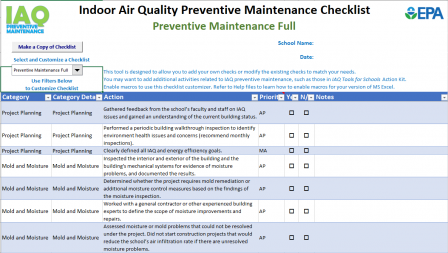
If you have existing IAQ management or preventive maintenance plans, you can cross-check them against the following checklists and schedules to ensure they cover everything. If you are starting from scratch, these resources can help you build your checklists:
- Appendix A: IAQ Preventive Maintenance Checklist20 is a customizable Excel checklist that includes actions specific to IAQ preventive maintenance. Appendix E: Annual Facility Equipment Preventive Maintenance Timeline and Appendix H: Example Preventive Maintenance Schedule both provide a starting point to develop your own schedule.
- General Services Administration Public Buildings Maintenance Standards —
- Includes a preventive maintenance list of standards for several types of equipment that you will find in a school building.
- Provides a list of maintenance frequencies—annually, semiannually, monthly, weekly, daily—for all the procedures (Section 2: Maintenance Standard Listing).
- Preventive Maintenance Template is an example set of activities from Vancouver (Canada) School Board School District #39.
- Manufacturer recommendations for each piece of equipment will include preventive maintenance procedures and frequencies.
Walkthroughs and Assessment
The Framework for Effective IAQ Management in Schools
Many of the strategies suggested in this guide are grounded in the IAQ Framework. The Key Drivers of the Framework provide detailed information about proven strategies, organizational approaches and leadership styles that are fundamental to program effectiveness; the Technical Solutions define the most common issues that schools need to address to effectively manage IAQ risks.
The facility walkthrough and assessment can help you develop your IAQ preventive maintenance plan (i.e., taking inventory of your equipment and preparing checklists and schedules). You should conduct facility walkthroughs and assessments at least once per year to evaluate your plan and to make sure your plan is up to date. Inspecting your facilities during a walkthrough combined with an in-depth analysis of your inventory and equipment conditions will give you a full picture of needed and potential maintenance and repairs to reduce or avoid future problems.21 Use what you learn during a walkthrough to tailor your IAQ preventive maintenance program for your school district’s specific needs. Learn more in the webinar “From Roof to Curb: Taking a Comprehensive Approach to IAQ Management Through Preventive Maintenance.”22
Several tools are available for your use when assessing your facilities:
- Appendix A: IAQ Preventive Maintenance Checklist: Once you have developed your tailored checklist, use it to assess your activities and take notes of items to update or add during a walkthrough of your facilities.
- School IAQ Assessment Mobile App: In addition to assessing IAQ preventive maintenance activities, you can use this mobile app to assess the IAQ management actions taken in your school buildings during a walkthrough. The app includes a set of easy-to-follow checklists; all you need is an internet connection. After your IAQ walkthrough, you can use the mobile app to submit your completed checklists by email to your school district’s designated IAQ coordinator or the person who oversees IAQ management for review and follow-up action. You can attach photos and detailed notes in your completed checklist submission.
During your walkthrough and assessment, you can gather data on regular performance to identify areas for improvement and establish metrics to help track your program’s impact over time. See the Evaluation section of this document.
IAQ Technical Solutions
Each school district will have unique IAQ challenges, but you likely will run into common IAQ issues that should be included in your preventive maintenance plan. This section will cover these common IAQ issues related to preventive maintenance (see Graphic 4) and key resources to address them.
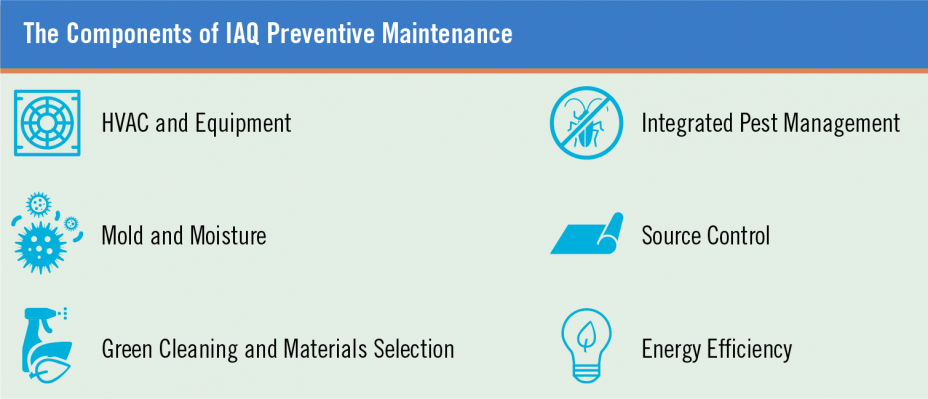 Graphic 4. These Technical Solutions can be used to address common IAQ issues related to preventive maintenance.
Graphic 4. These Technical Solutions can be used to address common IAQ issues related to preventive maintenance.
Key Technical Solutions for Common IAQ Issues
Learn more about the most common issues that schools need to address to effectively manage IAQ risks in the Framework—Technical Solutions to Common Indoor Air Quality Issues in Schools.
Creating green, clean and healthy schools requires mastering the school environment using a comprehensive approach to IAQ management. The web-based trainings in the IAQ Master Class Professional Training Webinar Series and IAQ Knowledge-to-Action Professional Training Webinar Series provide school district staff across the country with the knowledge needed to start, improve or sustain an IAQ management program within their school or school district. Each pre-recorded webinar features technical experts, industry leaders and model school districts, and is followed by a 30-minute mentoring question-and-answer session. Gain recognition for your knowledge achievement and commitment to action through certificates of completion and continuing education units for each training.
For more in-depth information, see the IAQ Tools for Schools Action Kit—Technical Solutions to Common IAQ Issues in Schools and EPA’s IAQ Professional Training Webinars for schools.
HVAC and Equipment
Monitoring your school’s HVAC system using preventive maintenance is like an early warning system—doing so will help you find problems before they find you. When your HVAC system is working correctly, your facilities have better air circulation and odor control, as well as a reduced level of pollutants. Additionally, a well-maintained HVAC system can help your school save money from unexpected repairs. Regular inspection and keeping the system clean and exhaust systems clear help prevent problems that could require expensive repairs. For example, a missing filter could, over time, lead to plugged coils, reduce your HVAC system’s effectiveness, contribute to poor IAQ, and result in substantial repair or replacement costs to HVAC system components. Routinely checking vents and HVAC ducts could reveal issues before they become problems, such as pests that can damage HVAC components that require expensive repairs.
Key Resources: HVAC
- Technical Solutions to Common Indoor Air Quality Issues in Schools—Provide Quality HVAC
- Ventilation Checklist from IAQ Tools for Schools Action Kit
- Webinar: “Better Together: Gaining Buy-In for Optimal Ventilation”
- Webinar: “Clean Air in the Classroom: Improve Air Quality, Extend HVAC System Life With Preventive Maintenance”
Mold and Moisture
Conduct routine inspections for moisture. Take actions to address mold and moisture problems immediately to protect IAQ. The best way to control indoor mold growth is to control moisture. Mold can cause a variety of health problems, increase allergic reactions and cause asthma attacks. Mold can grow on any organic surface if enough moisture and oxygen are available. Facility neglect often leads to moisture problems, especially when roofs, plumbing or ventilation systems are not routinely inspected. Mold can discolor surfaces, deteriorate building material, and lead to health problems for students and staff.
Green Cleaning and Materials Selection
Green cleaning products and maintenance practices can increase a school building’s life span and cut unexpected costs. They also can be less harmful to student and staff health and IAQ than traditional products and practices. Choose products with few effects on human health and the environment and that might contain recycled content. Also look for products and services that minimize waste, conserve energy or water, or reduce the amount of toxics used or left behind, such as products that meet EPA’s SaferChoice Standard. When building a new school, talk about the materials selection with building planners and design architects. Making smart choices about materials upfront can have a big impact on creating healthy indoor environments.
Key Resources: Green Cleaning and Materials Selection
- Technical Solutions to Common Indoor Air Quality Issues in Schools—Effectively Clean and Maintain
- Technical Solutions to Common Indoor Air Quality Issues in Schools—Make Smart Materials Selections
- 5 Steps to Green Cleaning in Schools
- Webinar: “Green, Clean and Healthy: Effective Cleaning and Preventive Maintenance for a Healthier School Environment”
- EPA’s SaferChoice Product Information
Integrated Pest Management
Pests can be a major, hard-to-manage problem in schools. Not only can they damage school facilities, but they also can cause IAQ and health problems for students and staff. Deferring maintenance of your building can cause it to start deteriorating, which gives pests easy entry points, such as wall cracks, and ideal living situations, such as leaky areas or poorly cleaned spaces. IPM is environmentally friendly and favors common-sense actions to prevent pests, using pesticides only as needed. IPM strategies remove things that pests need to survive—food, water and shelter—and block possible entry points to the building. Through routine inspections and keeping facilities and equipment in good working condition, IPM can keep pests at bay and prevent possible reentry
Key Resources: Integrated Pest Management
Source Control
Eliminating or reducing individual pollution sources, such as chemicals, radon, pesticides, emissions, etc., can improve IAQ and student and staff health. Source control is critical for reducing pollutant exposures and expensive accidents. You can minimize the use of hazardous chemicals at schools by using pollution prevention principles and looking for safer alternatives. Consider the possible health, safety and environmental consequences before buying a particular chemical. Create a purchasing policy that promotes environmentally preferable products, and conduct periodic inventories of the chemical products in your school to identify hazards. Use and treat chemicals properly, including storage, labeling and disposal, and include that guidance in your IAQ preventive maintenance program. Place walk-off mats at entrances to prevent dirt and pollutants from being tracked into the school. Consider implementing tobacco-free and anti-idling school bus policies. Additionally, you can test for certain pollutants (e.g., radon) and mitigate if necessary.
Key Resources: Source Control
- Technical Solutions to Common Indoor Air Quality Issues in Schools—Source Control and Chemical Management
- Walkthrough Inspection Checklist from IAQ Tools for Schools Action Kit
- Webinar: “Pollution Solution: How to Create IAQ Policies, Plans and Practices to Control Pollutant Sources in Your School District”
Energy Efficiency
There is a close connection between IAQ, energy efficiency and preventive maintenance, and how they impact the school environment. (For more information, see The Value of IAQ Preventive Maintenance: Saving Costs With Healthy, Reliable and Efficient Buildings section.) Poor energy management can create IAQ problems and lead to poor ventilation in occupied spaces. Preventive maintenance plans can include proactive actions to improve energy efficiency while ensuring that IAQ is protected. School districts also can include IAQ protections in their energy efficiency retrofits and other building upgrade projects to make the best possible improvements without risking student and staff health. The Energy Savings Plus Health: Indoor Air Quality Guidelines for School Building Upgrades guide provides in-depth information and guidance for incorporating IAQ into energy efficiency projects, and you can use the Interactive Air Quality Planner to create a checklist tailored to your school district’s needs.
Key Resources: Energy Efficiency
- Protecting IAQ During School Energy Efficiency Retrofit Projects With Energy Savings Plus Health Guidelines
- Webinar: “Getting Started With Energy Savings Plus Health: How to Integrate Energy Efficiency With Health and Safety Outcomes in Your School"
- Webinar: “Making the Connection: Linking IAQ, Energy Efficiency and Preventive Maintenance Together for Healthy Schools"
In addition, be aware of certain hazardous substances (listed below) and take steps to prevent exposure to them.23 While some of these substances might be mentioned briefly in this document, it is important to get information from resources specific to a particular hazard to prevent exposure.
-
Lead: Lead is highly toxic and, during preventive maintenance activities, it is important to follow lead-safe work practices. “If surfaces have lead paint, even a small maintenance job like drilling a hole can produce enough lead dust to poison a child.”24 For more information, see EPA’s webpage Lead Concerns During Renovations for a Healthy School Environment.
-
Asbestos: Asbestos materials can become hazardous when fibers are released due to damage or deterioration over time. If the fibers are inhaled, they can lead to health problems. For more information, see EPA’s webpage Asbestos and School Buildings.
-
Polychlorinated biphenyls (PCBs): PCBs are one of the most widely studied environmental contaminants and have been demonstrated to cause a variety of adverse health effects. If PCBs are present or suspected of being present, EPA recommends that school administrators, building owners and building managers take action to reduce PCB exposures. For more information, see EPA’s webpage Polychlorinated Biphenyls (PCBs).
-
Radon: Radon is a radioactive gas that can cause lung cancer. EPA ranks indoor radon among the most serious environmental health problems facing us today. The only way to determine if a school has high levels of radon is to test for it. For more information, see EPA’s webpage Radon in Schools.
Staffing and Communication
Showcasing Success
“Upper Merion Area School District created a new position dedicated to coordinating energy management and preventive maintenance. By implementing cost-saving actions, this coordinator has paid for his own salary about four or five times over every year.”
—Fred Remelius, Director of Operations, Upper Merion Area School District, Pennsylvania
U.S. EPA. 2017. “A Proactive Approach to IAQ: Saving Money and Protecting Health With Preventive Maintenance.” Webinar held November 9, 2017.
Forming a committed team responsible for your IAQ preventive maintenance program can position you for success and make sure your program runs efficiently. Begin by assigning one person as the IAQ Preventive Maintenance Coordinator—even if that is just one aspect of their job—to give you a point person who can keep track of the activities and oversee the development and sustained consistent implementation of the program. Ideally, your team should include at least one person with the authority to make district-wide decisions, such as the Energy Manager, Facilities Director or other equivalent staff member. The team also should include key players in the school’s day-to-day operations—such as custodians, technicians and building engineers—whose knowledge about building systems and roles in taking care of school buildings and grounds make them critical to the plan’s success. An effective IAQ preventive maintenance plan cannot be crafted without their specific expertise, and they know how to predict, prevent and resolve identified problems. Learn more in the webinar “All In for IAQ Preventive Maintenance: Key Strategies for Training Staff and Communicating Success.”15 IAQ Coordinators and Sustainability Coordinators also can bring valuable issue-specific knowledge.25
Finding Mentors and Sharing Best Practices
Forging relationships with neighboring school districts that have good IAQ preventive maintenance practices could be beneficial in learning proven approaches. Consider hosting or joining a series of conference calls to further bolster your IAQ preventive maintenance program with additional best practices, and share what you have learned with other schools. Identify IAQ champions near you or email IAQschools@epa.gov to be connected with IAQ champions.
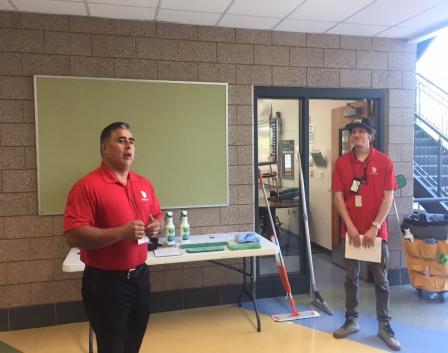 Maintenance and custodial staff training is critical to the success of protecting IAQ in Salt Lake City School District, UT
Maintenance and custodial staff training is critical to the success of protecting IAQ in Salt Lake City School District, UT
Many schools rely on contractors to assess their buildings and to conduct investigations and remediation. Therefore, contractors working on activities related to preventive maintenance should be aware of the plan, follow recommendations when providing services, and be part of the team when possible and when useful. This guide and the IAQ preventive maintenance plan can be important tools to ensure that contractors have the knowledge and are equipped to successfully implement the plan to protect health, improve energy efficiency and reduce unexpected costs.
Once the team is in place, regular, clear communication will help everyone understand the importance of IAQ preventive maintenance. Think about adding communications strategies to your IAQ preventive maintenance plan. For example, training staff, holding regular meetings, creating reports and sharing information will help to raise awareness and increase buy-in.
 Recognition is a great way to motivate staff. Certificates of Completion are available for EPA’s IAQ Professional Training Webinars.
Recognition is a great way to motivate staff. Certificates of Completion are available for EPA’s IAQ Professional Training Webinars.
- Training: Training the staff who will put your plan in place is critical for success. You also can use online training, depending on the knowledge your team needs. EPA offers a variety of no-cost, online training sessions that can be viewed on-demand, covering such topics as IAQ preventive maintenance, conducting walkthroughs and assessments, IPM and green cleaning, HVAC and equipment upkeep, and mold and moisture prevention.
- Meetings: Meeting regularly with the team keeps lines of communication open. Use meetings to discuss what actions your team has taken and compare your results to the goals you set.
- Reports: Creating end-of-year reports can help communicate your IAQ successes and how preventive maintenance played a part. Reporting will help you make the case to protect future IAQ preventive maintenance budgets.
- Newsletter articles or online posts: Including a write-up in the school newsletter or website can communicate your goals, your successes and the benefits of IAQ management to others in the school district and the community.
Evaluation
As you develop your IAQ preventive maintenance plan, keep in mind your program goals and how you will measure achievement of those goals. This will become the foundation for evaluation. Evaluating how your IAQ preventive maintenance plan has affected student health and achievement, as well as the building’s performance, is critical. It enables you to continuously improve your program and capture your return on investment (ROI).26 Proactive evaluation will help you show that preventive maintenance saves money over time.
Use the information you collected during your IAQ preventive maintenance activities to calculate your ROI following the steps outlined below. To learn more about ROI and making the case, view “A Proactive Approach to IAQ: Saving Money and Protecting Health with Preventive Maintenance.”
Evaluation also can help you assess the success of your work and better understand the methods you used so you can refine your approach and plan as needed. These steps can help you develop an approach to evaluating your efforts:
Create tracking sheets/tables to record collected data. Having metrics will allow you to evaluate your program’s progress and impact.
- Appendix D: IAQ Preventive Maintenance Sample Equipment Inventory
- Appendix E: Annual Facility Equipment Preventive Maintenance Timeline
- Appendix F: Sample IAQ Measurements Tracking Sheet
- Appendix G: Monthly Health Statistics
- Utility (Energy, Water and Waste) Measuring and Tracking Tool: EPA’s ENERGY STAR® PortfolioManager®
- Computerized Maintenance Management System (CMMS): Tracks Preventive Maintenance Activities and Repairs
Decide which data points to track, based on the goals set in your plan. As noted in the earlier section, Making the Case, goals should be tangible and measurable to help facilitate evaluation. Key data points might include:
- Average number of IAQ complaints per month
- Positive responses from building occupants
- Changes in the number of school nurse visits
- Attendance and school test scores over time
- Average temperature, relative humidity, carbon dioxide levels and ventilation rates
- Frequency of HVAC filter changes
- Energy use
-
Lifecycle of the building and equipment21
You also can refer to Appendix C: IAQ & Preventive Maintenance Value Proposition Worksheet.
Create baselines centered on your overall goals. For example, if your goals are to reduce IAQ complaints and energy use, choose a baseline year and compare the progress from your plan’s activities against that year.
- Analyze your baseline data and determine why high or low data points may have occurred. Adjust your data to eliminate the effects of extreme events such as longer-than-usual school closures due to weather conditions. Record the causes for these irregularities.27
- Create tables and graphs for an easy view of how your data change over time, such as the difference in reported asthma cases, ENERGY STAR® score or energy use intensity.
Find ways to compare your data to those from other schools or resources.
- Use the data you collected for different purposes—such as energy use or reduced illnesses—to evaluate your progress. Support your results and arguments with tables and graphs that show your progress over time.
 Use EPA’s ENERGY STAR® Portfolio Manager® to compare your school’s energy performance against others in your portfolio and schools across the United States. If you cannot find outside databases for other metrics, create your own or work with districts in the region to do so. You also can use your own buildings’ baselines to compare their performance over time.
Use EPA’s ENERGY STAR® Portfolio Manager® to compare your school’s energy performance against others in your portfolio and schools across the United States. If you cannot find outside databases for other metrics, create your own or work with districts in the region to do so. You also can use your own buildings’ baselines to compare their performance over time.- Compare your data with neighboring school districts, working with local or state governments if needed.
- Look for national statistics or standards that nongovernmental organizations or federal agencies might provide, such as American Society of Heating, Refrigerating, and Air-Conditioning Engineers (ASHRAE) Standards 55 and 62.28, 29 For example, under current ASHRAE Standard 62, the outdoor air ventilation rate for classrooms is about 15 cubic feet per minute of outdoor air per person.30
Reassess and fine-tune your goals. In most cases, the goals you initially set may need to be adjusted, or new goals may emerge over time. Reassessing your goals based on actual experience and more recent data will help you refine your future actions. An IAQ preventive maintenance plan should be a living document and not “set in stone.”
- Compare your results against the goals you set in your plan.
- Conduct a cost-benefit analysis of your program (a comparison of values of all benefits minus related costs). Consider taking a comprehensive approach by estimating the costs saved over the lifetime of your equipment, in addition to including the initial cost of IAQ preventive maintenance activities.
- Compare the data over time with baseline data to see whether your actions made a difference. If they did not, determine what did not work and why, and adjust your plan and actions.
- If your baseline data are too old and no longer show current market conditions, consider gathering data to create new baselines.
Continue to make the case for your IAQ preventive maintenance program by sharing your progress with key decision-makers and other stakeholders. Revise your value proposition as needed to reflect your program as it evolves.
- Appendix A - IAQ Preventive Maintenance Checklist Generator v1.0(270 K, August 2020)
- Appendix B: IAQ Preventive Maintenance Plan(8 pp, 88 K)
- Appendix C: IAQ & Preventive Maintenance Value Proposition Worksheet
- Appendix D: IAQ Preventive Maintenance Sample Equipment Inventory(17 pp, 98 K)
- Appendix E: Annual Facility Equipment Preventive Maintenance Timeline (14 pp, 119 K)
- (Source: New York State Energy Research and Development Authority [NYSERDA])
- Appendix F: Sample IAQ Measurements Tracking Sheet(1 pg, 52 K)
- Appendix G: Monthly Health Statistics(1 pg, 59 K)
- Appendix H: Example Preventive Maintenance Schedule
- (Source: Minnesota Department of Health)31
1 The guide does not (1) set new EPA regulatory requirements or in any way change or override existing EPA regulatory requirements, (2) give guidance about diagnosing occupant health problems or building-related illness, (3) make training or training documents unnecessary, (4) give detailed guidance about how to meet each recommendation in all situations, or (5) identify available funding or funding sources.
2Access this guidance and associated appendices on EPA’s website. www.epa.gov/iaq-schools/indoor-air-quality-tools-schools-preventive-maintenance-guidance-documents.
3 Council of the Great City Schools. 2014. Reversing the Cycle of Deterioration in the Nation’s Public School Buildings. Washington, D.C.: Council of the Great City Schools. www.cgcs.org/cms/lib/DC00001581/Centricity/Domain/87/FacilitiesReport2014.pdf.
4 U.S. EPA. 2017. “A Proactive Approach to IAQ: Saving Money and Protecting Health With Preventive Maintenance.” Webinar held November 9, 2017. www.epa.gov/iaq-schools/forms/webinar-proactive-approach-iaq-saving-money-and-protecting-health-preventive.
5 U.S. EPA. 2014. Energy Savings Plus Health: Indoor Air Quality Guidelines for School Building Upgrades. EPA 402/K-14/001. 19january2021snapshot.epa.gov/sites/static/files/2014-10/documents/energy_savings_plus_health_guideline.pdf
6 U.S. EPA. “How Does Indoor Air Quality Impact Student Health and Academic Performance?” Accessed December 13, 2018. www.epa.gov/iaq-schools/how-does-indoor-air-quality-impact-student-health-and-academic-performance.
7 Harvard T.H. Chan School of Public Health. n.d. Schools for Health: Foundations for Student Success. Healthy Buildings Team, Center for Health and the Global Environment. Boston, MA: Harvard T.H. Chan School of Public Health. forhealth.org/Harvard.Schools_For_Health.Foundations_for_Student_Success.pdf.
8 U.S. EPA. 2003. Indoor Air Quality Tools for Schools Communications Guide. EPA 402-K-02-008. 19january2021snapshot.epa.gov/sites/static/files/2014-08/documents/communicationsguide.pdf.
9 Curreri, M., D. Berger, and K. Ütebay. 2016. “Achieving Indoor Air Quality, Health and Performance in Schools.” Presented at the 2016 Council of the Great City Schools Chief Financial Officers Conference, San Antonio, TX, November 09, 2016.
10 U.S. EPA. 2017. “Using Data to Drive Buy-In and Funding to Reduce Asthma Triggers: The Value Proposition of School IAQ Management.” Webinar held on May 4, 2017. www.epa.gov/iaq-schools/forms/webinar-using-data-drive-buy-and-funding-reduce-asthma-triggers-value-proposition.
11 Institute of Educational Sciences, National Center for Educational Statistics. 2014. Condition of America’s Public School Facilities: 2012–13. https://nces.ed.gov/pubs2014/2014022.pdf.
12 21st Century School Fund. 2016. State of Our Schools: America's K–12 Facilities. Washington, D.C. 21st Century School Fund, Inc., U.S. Green Building Council, Inc., and the National Council on School Facilities. centerforgreenschools.org/state-our-schools.
13 U.S. EPA. 2016. Protecting Indoor Air Quality During Renovations: Des Moines Public Schools’ Success Story. Results obtained by Des Moines Public Schools, Des Moines, Iowa.
14 U.S. EPA. 2017. “Indoor Air Quality & Preventive Maintenance Value Proposition Worksheet.” Last modified November 2017. www.epa.gov/iaq-schools/indoor-air-quality-preventive-maintenance-value-proposition-worksheet.
15 U.S. EPA. 2018. “All In for IAQ Preventive Maintenance: Key Strategies for Training Staff and Communicating Success.” Webinar held September 27, 2018. www.epa.gov/iaq-schools/forms/webinar-all-iaq-preventive-maintenance-key-strategies-training-staff-and.
16 Landrigan, P. J., C. A. Kimmel, A. Correa, and B. Eskenazi. 2004. “Children’s Health and the Environment: Public Health Issues and Challenges for Risk Assessment.” Environmental Health Perspectives. 112(2):257–265. www.ncbi.nlm.nih.gov/pmc/articles/PMC1241836/pdf/ehp0112-000257.pdf.
17 U.S. EPA Office of Research and Development. 2007. A Decade of Children’s Environmental Health Research: Highlights From EPA’s Science To Achieve Results Program. EPA/600/S-07/038. 19january2021snapshot.epa.gov/sites/static/files/2015-09/documents/decade-of-childrens-health-full-report.pdf.
18 U.S. EPA. 2012. “State School Environmental Health Guidelines.” Last modified October 14, 2016. www.epa.gov/schools/read-state-school-environmental-health-guidelines.
19 U.S. EPA. 2012. Student Health and Academic Performance: Quick Reference Guide. 19january2021snapshot.epa.gov/sites/static/files/2014-08/documents/student_performance_findings.pdf.
20 This checklist includes activities specifically related to increasing reliability, efficiency and health. These are a subset of a full IAQ management plan, a full energy savings plan and a full preventive maintenance plan.
21 U.S. EPA. n.d. Envisioning Excellence—The IAQ Tools for Schools Program Change Package. https://nepis.epa.gov/Exe/ZyPDF.cgi/P100735B.PDF?Dockey=P100735B.PDF.
22 Lewek, D. 2016. “Preventive Maintenance, Proactive Facility Management.” Facility Executive. March 3, 2016. facilityexecutive.com/2016/03/preventive-maintenance-facility-management.
23 In this document, “hazardous” refers to substances that could be harmful to human health and/or the environment and must be removed and disposed of by licensed professionals. (Excerpt from Energy Savings Plus Health: Indoor Air Quality Guidelines for School Building Upgrades.)
24 Arroyo, M. G., G. Bateson, R. Dewey, L. Dionne, C. Foghorn, and B. Plog. 2000. Working in a Lead-Safe School: Facts for School Maintenance Workers. University of California at Berkeley. www.lohp.org/docs/pubs/lead/LEADSAFE.PDF.
25 U.S. EPA. 2009. “Coordinator’s Guide for Indoor Air Quality: A Guide to Implementing an IAQ Program.” Last modified September 12, 2017. www.epa.gov/iaq-schools/coordinators-guide-indoor-air-quality#IAQCG_Section2_Form.
26 U.S. EPA. n.d. “The Framework for Effective School Indoor Air Quality Management: Key Drivers.” Last modified September 8, 2016. www.epa.gov/iaq-schools/framework-effective-school-indoor-air-quality-management-key-drivers.
27 U.S. EPA. n.d. IAQ Tools for Schools Approach: Providing a Framework for Success. 19january2021snapshot.epa.gov/sites/static/files/2018-08/documents/iaq_2018_management_framework_success_3page_508_final_2.6.18.pdf.
28 ASHRAE. 2017. Standard 55 – Thermal Environmental Conditions for Human Occupancy. www.ashrae.org/technical-resources/bookstore/standard-55-thermal-environmental-conditions-for-human-occupancy.
29 ASHRAE. 2017. Standards 62.1 & 62.2.www.ashrae.org/technical-resources/bookstore/standards-62-1-62-2.
30 U.S. EPA. n.d. Technical Solutions to Common Indoor Air Quality Issues in Schools. www.epa.gov/iaq-schools/technical-solutions-common-indoor-air-quality-issues-schools.
31 Minnesota Department of Health. Model IAQ Plan in Schools. Introduction to the Indoor Air Quality Management Plan Development Package. Accessed December 13, 2018. www.health.state.mn.us/communities/environment/air/schools/plan.html.
You may need a PDF reader to view some of the files on this page. See EPA’s About PDF page to learn more.
- IAQ TfS Preventive Maintenance Guidance (PDF)(27 pp, 6 MB, March 2019, EPA 402-K-18-001 )

